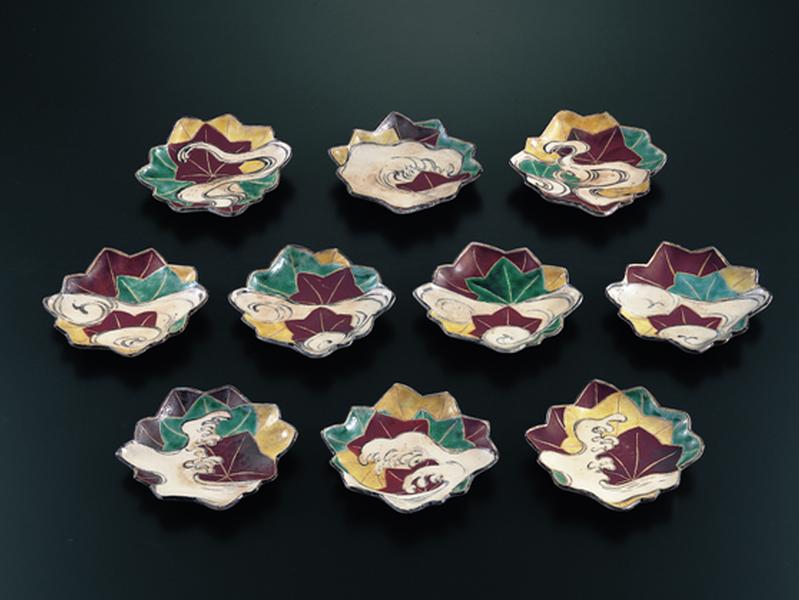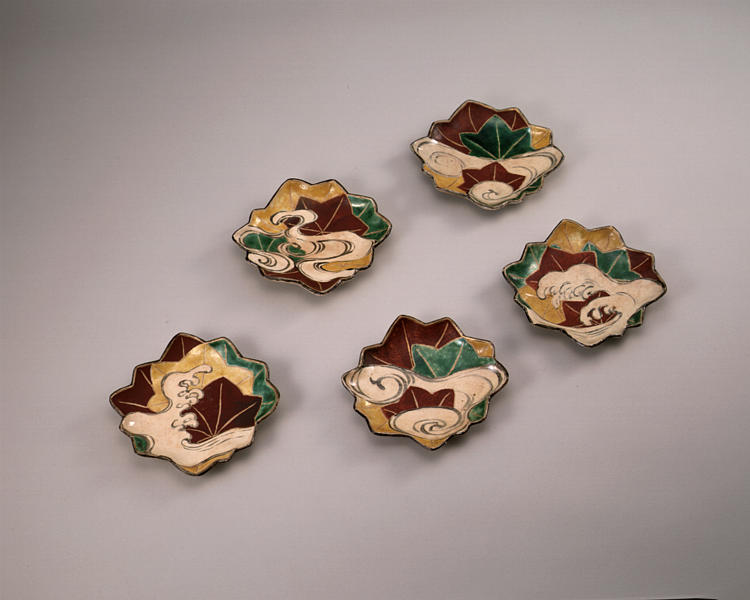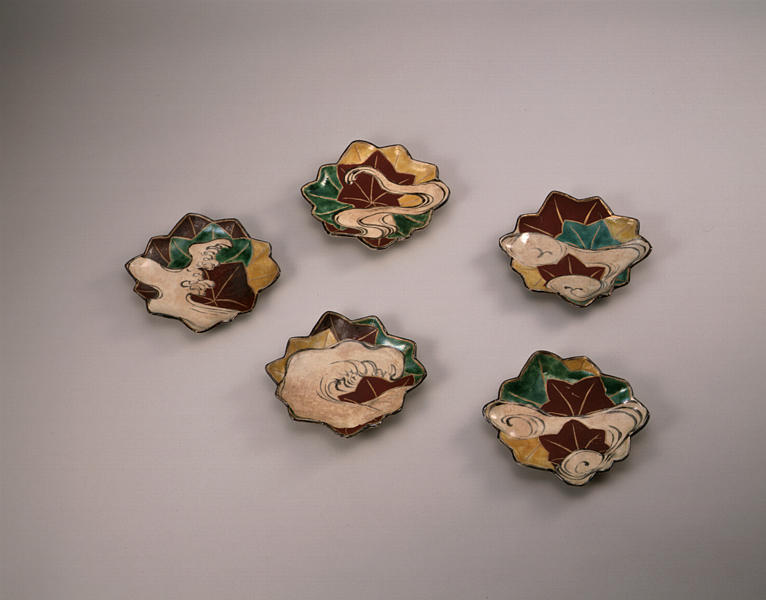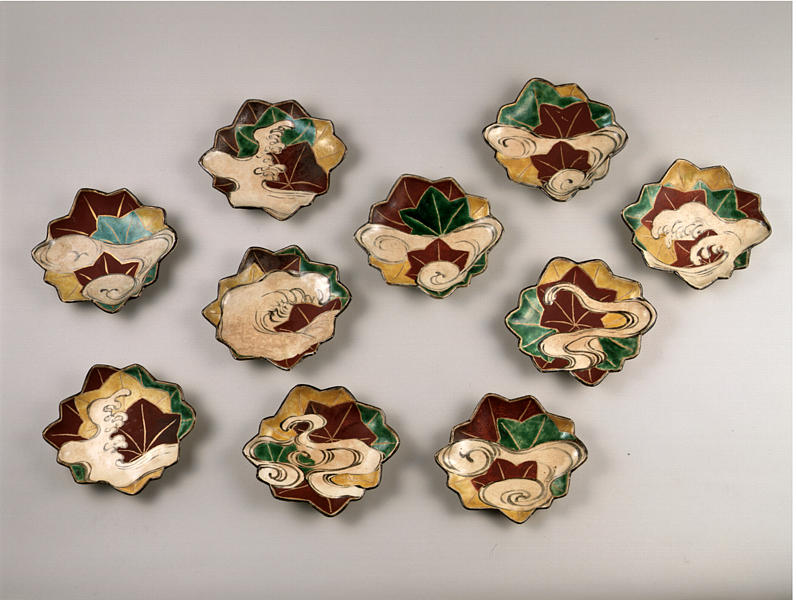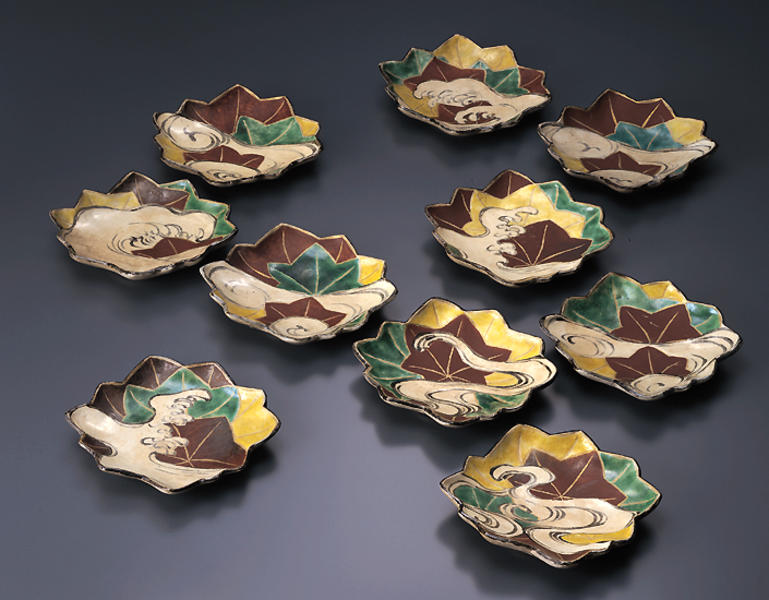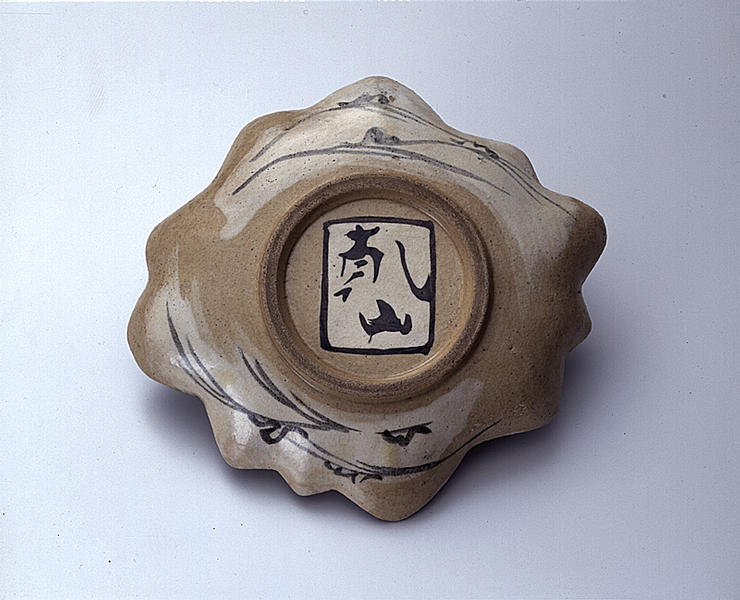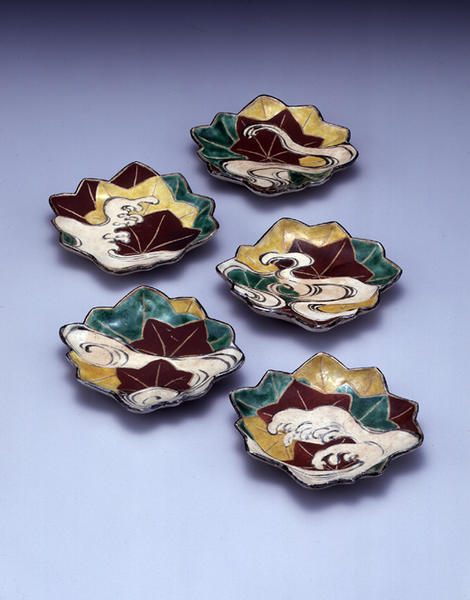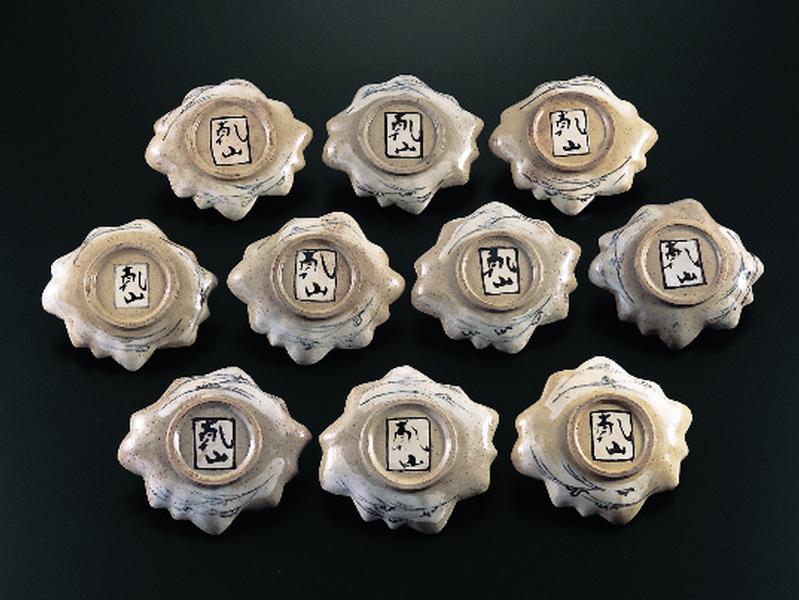乾山色絵竜田川図向付
- 京都・二条丁子屋町
- 江戸時代
- 18世紀
- 乾山陶製、色絵
- H-3.4 D-16 W-18.2
- 所蔵
- 井上馨旧蔵
江戸時代 18世紀
高:3.4cm 径:16.3-18.0cm 高台径:9.0cm
体部は型造りで,高台は貼り付け高台である。素地の上に白泥を刷毛塗りし,銹絵で流水文を描き込んでから,半透明の釉を掛けて本焼きしている。上絵は重なり合う紅葉の葉を金彩で縁どってから,赤・黄・緑の三色の絵の具が施されている。
十客すべての高台内に,角枠付の「乾山」銘が銹絵で記されているが,明らかに筆跡の異なるものが認められる。また,上絵の具の塗りむらの濃淡や,白泥の塗り方(塗布部分)にも個体によって違いがあることから,複数の工人によって作られた工房作品ではないかと考えられ,乾山焼としてはやや新しい時期に属するものではないかと思われる。
一般にこの手の向付は,乾山の二条丁子屋町時代の作品とされることが多いが,鳴滝の窯跡から同種の型物が出土しているという指摘もあり,製作時期の特定は難しい。十客中二客の高台畳付に付着した窯道具が残っている。 (尾野)
尾形乾山
尾形乾山(おがたけんざん 1663~1743)
乾山は、寛文3年(1663)京都の富裕な呉服商尾形宗謙(おがたそうけん)の三男として生まれました。兄は画家の光琳です。二人の性格は対象的で、光琳が派手好みであったのに対し乾山は内省的、隠遁的な性格の持主であったといわれています。
野々村仁清に陶芸を学んだ乾山は、元禄12年(1699)37歳のとき京都市の鳴滝に開窯しました。そして正徳2年(1712)50歳の乾山は、京市内の二条丁子屋町に移住し、多くの作品を手がけ「乾山焼」として世にもてはやされました。鳴滝時代の末期からこの丁子屋町時代にかけて兄の光琳は絵付で乾山を助け、兄弟合作の作品が数多く残されています。
享保16年(1731)69歳の頃に江戸に下り寛永寺(かんえいじ)領入谷(いりや)に窯を築いて晩年を送りました。そして81歳で没するまで江戸に在住し陶器や絵画の制作に手腕を発揮しました。
乾山の作品は陶芸作品のみならず書や絵画においても、俗気を脱したおおらかで文人的な洒脱味があります。陶芸作品においては成形、施釉、焼成は他の専門的な陶工に任せたり、絵付についても光琳との合作以外に複数の専門画家が携わっていたと思われるなど、基本的には工房生産という態勢をとっていたようです。しかし、乾山の指導のもとにつくられたやきものには、その大胆なデザイン感覚とともに乾山特有の芸術性が溢れ、乾山その人とふれあうような親しみが感じられるのです。
乾山銹絵染付掻落絵替汁次
乾山銹絵染付梅波文蓋物
乾山立鶴図黒茶碗
乾山銹絵染付桔梗図筒向付
乾山銹絵染付草文四方鉢
乾山銹絵染付松図茶碗
乾山色絵短冊皿
乾山銹絵絵替長平皿
乾山色絵寿字輪花向付
乾山銹絵絵替四方皿
乾山銹絵染付絵替筒向付
乾山銹絵染付松図茶碗
乾山色絵椿文向付
乾山銹絵染付春草図茶碗
乾山銹絵染付藤図向付
乾山色絵立葵図向付
乾山色絵雪杉図向付
乾山色絵桔梗文盃台
乾山銹絵馬図香合
乾山銹絵染付絵替扇形向付
乾山銹絵掻落雲唐草文大鉢
乾山銹絵草花波文水指
乾山銹絵染付絵替土器皿
乾山色絵槍梅図茶碗
乾山黒楽梅図茶碗
乾山銹絵染付芙蓉図茶碗
銹絵掻落牡丹唐草文香合
撫子図(尾形乾山筆)
乾山色絵和歌陶板
乾山銹絵牡丹画角皿 尾形光琳画
乾山銹絵百合形向付
乾山銹絵松文香合
乾山色絵阿蘭陀写市松文猪口
乾山色絵薄図蓋茶碗
乾山銹絵菊図水指
鶴亀図黒茶碗
紅葉図 尾形乾山筆
三十六歌仙絵/在原業平像 尾形乾山筆
三十六歌仙絵/斎宮女御像 尾形乾山筆
乾山色絵菊文手付汁次
三十六歌仙絵/小野小町像 尾形乾山筆
乾山銹絵染付山水図茶碗
Catalogue Entry
Set of 10 dishes
Edo period, 18th century
Kenzan ware, underglaze iron and overglaze polychrome decoration
Height, 3.4cm; diameter, 16.3-18.0cm;
foot diameter, 9.0cm
The bodies of these dishes were mold-cast, and then a foot was applied to the molded body. A white slip was brushed onto the plain clay surface, and a flowing water pattern was painted in underglaze iron on this surface. Then a transparent glaze was applied to the entire piece, and the works were fully fired. The overglaze paintings were then formed by outlining layered maple leaves in gold pigment and decorating these leaves with one of three colors of pigment--red, yellow, or green.
All of the ten dishes are inscribed "Kenzan" in underglaze iron in a square frame on the interior of the foot, and yet distinctive differences can be noted in the brush styles of these inscriptions. Further, the variations in the thickness of the overglaze pigments and the manner in which the white slip was brushed (areas where it is applied) also reveal individual characteristics, thus indicating that these works might be considered to have been studio works created by a variety of potters. They can also be considered relatively late examples of Kenzan ware. Generally, the mukozuke dishes of this type are considered to have been works from Kenzan's Nijo Chojiyamachi period, but as similar shaped mold-cast works have been excavated from the Narutaki kiln, it is hard to determine the date of their production. 2 of the 10 dishes have kiln supports still attached to the bottom of their feet. YO
解説(春の玉手箱)
尾形乾山(一六六三~一七四三)は光琳の実弟。仁清に作陶技法を学び京都の北西(乾)に鳴滝窯を開いたため、「乾山焼」の呼称が生まれた。数ものの食器が多く、工房として複数の職人が制作に携わっていたと考えられているが、器胎自体をキャンバス代わりにし、和歌や漢詩を書き付け、草花をデフォルメし、色絵付けをするなど、優れたデザイナーぶりを発揮している。本作も型造りによる成形に高台を貼り付けたもので、素地の上に白泥を刷毛塗りし,銹絵で流水文を描き込んでから,半透明の釉を掛けて本焼きしている。上絵は重なり合う紅葉の葉を金彩で縁どってから,赤・黄・緑の絵具を施し、紅葉漂う竜田川を情緒たっぷりに表現している。流水や紅葉の配色を巧みに変え、型造りであることを感じさせない工夫がなされており、乾山の面目躍如といったところであろう。高台内には角枠付の「乾山」銘が記されている。
Catalogue Entry
Ogata Kenzan (1663‐1743) was Korin's younger brother. After studying Ninsei's pottery methods, Kenzan established the Narutaki kiln in Kyoto's northwest (sometimes called Ken) and from that his name “Kenzan," or “Ken mountain," was coined. He created a large number of sets of food dishes, and while it is thought that these works were created in a workshop environment by numerous craftsmen, Kenzan himself was superb designer, using these ceramic wares in place of a canvas, brushing on poems, uniquely askew flowers and grasses, and various overglaze enamels. The bodies of these dishes were mold‐cast, and then a foot was applied to the molded body. A white slip was brushed onto the plain clay surface, and a flowing water pattern was painted in underglaze iron on this surface. A transparent glaze was applied to the entire piece, and the works were fully fired. The overglaze paintings were then formed by outlining layered maple leaves in gold pigment and decorating these leaves with one of three colors of pigment‐‐red, yellow, or green. This maple leaf and water motif conveys an image of the Tatsuta River. Skillful variations in the flowing water pattern and colors chosen for the leaves belie the molded nature of these works and exemplify the sheer diversity of Kenzan's creative expression. The interior of the foot of each dish is inscribed “Kenzan" in a square frame.
